Likert scale best practices, examples, and survey questions

Surveys are a great way to understand the opinions, attitudes, and behaviors of a group of people—from customers to shoppers and employees. The challenge is: How do you turn a group's personal opinions into something that can be measured? Is there a way to capture sentiment about a product, a service, or an experience and rate it on a scale?
That's where Likert scale questions come in. A Likert scale is an interval scale that allows people to evaluate a statement or question with a quantitative value, such as "always," "often," "sometimes," "rarely," or "never." This rating scale gives companies the option of capturing more granular feedback on a subject than a yes/no question format can provide.
A Likert question presents respondents with multiple response options along a scale or continuum. For example, the answer options about shopping frequency might range from “always” to “sometimes” to “never.” This gives respondents the ability to express more measurable and nuanced opinions that help companies capture a complex array of attitudes and perceptions.
That’s why Likert scale questions are such a powerful tool for delving deeper into the psyche of customers. The scaled answers provide companies with richer insights to inform decision-making and strategy formulation.
Examples of Likert scale survey questions

A Likert scale question is versatile and can work for many use cases. It can ask respondents the level to which they agree with a statement, such as “How much do you agree or disagree,” but it can also measure sentiment about a statement.
A Likert question can ask respondents to rank a statement based on satisfaction, importance, frequency, likelihood, and more. This flexibility allows researchers and practitioners to tailor surveys to their specific needs and capture a wide range of insights.
For example, a Likert question about a product might be, “How satisfied are you with this product?” A Likert question about a shopping experience might ask, “How frequently do you shop on our website?” There are practically limitless possibilities for what kind of sentiment you can uncover.
The number of answer options for a Likert scale question is also flexible. A 7-point Likert scale question is thought to accurately reflect a respondent's true evaluation by offering a wide range of answer options. However, many believe a 4-point or 5-point Likert scale is easier for respondents to fill out because it takes less time and effort to complete.
One other variation to note on Likert scale questions is that they can be bipolar or unipolar. It’s somewhat of a semantic difference in how answer options are presented, but there can be reasons to choose either option.
A unipolar scale measures intensity in one direction—from extremely likely to not at all likely, for example, asking users to focus on the feeling around “likely.” It gives the option for users to choose a maximum amount of feelings about a particular sentiment, or none at all.
A bipolar matrix scale captures opposite spectrums of an attitude or perception. An example of a bipolar Likert answer series would range from “completely satisfied” to “completely dissatisfied.” Some believe that a bipolar scale allows for a more nuanced understanding of respondents' opinions.
While Likert scales are widely used, some researchers prefer the Guttman scale when they need to measure a single, cumulative dimension of attitudes or behaviors. The Guttman scale builds questions in a hierarchical order, where agreeing with higher-level items implies agreement with lower-level ones. Learn more about how to use Guttman scales in survey research to determine if this alternative scaling method might better suit your research needs.
Related reading: What is the Thurstone Scale? Definition and examples
Here are some popular examples of Likert questions, shown with a variety of options.
Event feedback surveys
Event feedback surveys are questionnaires sent to attendees after an event to capture their feelings. These surveys can contain Likert scale questions asking about a variety of aspects of the experience—how much they enjoyed the event, how much they liked or disliked activities, how they felt about the venue and facilities etc. Below is an example of a bipolar 4-point Likert question asking for event feedback.
How informative or uninformative was the keynote presentation?
- Very uninformative
- Somewhat uninformative
- Somewhat informative
- Very informative
Customer satisfaction surveys

Customer satisfaction surveys are used by businesses to measure customer sentiment. The questions in customer satisfaction surveys can cover various aspects of the customer experience, including product quality, customer service, ease of use, pricing, and overall satisfaction. The survey questions are often assessed on Likert scales.
Here’s an example of a bipolar 5-point Likert question, with a neutral option, for a customer satisfaction survey.
How satisfied or dissatisfied are you with the product quality?
- Very dissatisfied
- Somewhat dissatisfied
- Neither dissatisfied or satisfied
- Somewhat satisfied
- Very satisfied
Employee engagement surveys

Organizations conduct employee engagement surveys to gauge the level of engagement, satisfaction, and motivation among their employees. These surveys usually use Likert scale questions to ask employees about their workplace experiences, job satisfaction, company culture, and more.
Here’s an example of a unipolar 4-point Likert question that could be used in an employee engagement survey.
How comfortable do you feel expressing your thoughts and opinions at work?
- Very comfortable
- Somewhat comfortable
- Not too comfortable
- Not comfortable at all
Here’s an example of a bipolar 4-point Likert question that could be used in an employee engagement survey.
How comfortable do you feel providing feedback to your manager?
- Very uncomfortable
- Somewhat uncomfortable
- Somewhat comfortable
- Very comfortable
Product feedback surveys

Product feedback surveys are like conversations between companies and product users, where customers share their thoughts and experiences about a product or service. They usually have a series of Likert scale questions asking users what they think, what they like, and what they'd change about the product or service.
Below is an example of a unipolar 7-point Likert question that could be used in a product feedback survey.
How often do you use a mobile app for day-to-day tasks?
- Always
- Often
- Sometimes
- Rarely
- Never
Related reading: What is a Likert scale? Examples, tips, and how to analyze the data
Best practices for designing Likert scale questions
Use consistent design
Once you've settled on a Likert scale design, stick with it throughout your survey. This means maintaining consistency in factors like scale length, whether it's bipolar or unipolar, and the inclusion of neutral options. Consistency is crucial for ensuring a seamless and user-friendly survey experience.
Use contextual language
Instead of using generic terms like "agree" or "disagree," opt for specific response options that directly reflect the content of your questions. For instance, using descriptors like "satisfied" or "dissatisfied" provides clarity and helps respondents better understand the intent of the questions.
Avoid numbers, symbols, and emojis
Steer clear of using ambiguous labels in your Likert scales. Descriptive labels with clear language are more effective in preventing confusion and ensuring respondents accurately interpret the scale.
Use evenly-spaced scales
Ensure that the options on your Likert scale are evenly spaced to maintain clarity and avoid ambiguity, especially when using word labels. This helps respondents navigate the scale more easily and provides consistent interpretation of responses.
Use a full range of scale points
Cover all possible responses within your scales to accommodate the full range of experiences and opinions. For instance, if you're asking about service speed and options range from "extremely quick" to "moderately quick," make sure to include options for respondents who found the service to be slower than average.
Common Likert scale mistakes to avoid
Using ambiguous language
Be clear and direct with your questions. Vague or confusing language can make it hard for people to answer accurately. Specify clearly what you are asking respondents to rate. It will make it easy for people to provide answers and you will get more actionable insights from your survey. For example, instead of asking employees to rate their satisfaction with the company, ask them to rate their satisfaction with the work-life balance of the company.
Using biased language
Avoid leading or biased language that may sway respondents' responses in a particular direction. If possible, you should use “two-sided” languages in your Likert scale questions to avoid biasing respondents into thinking one way or the other.
For example, rather than asking “How satisfied are you with the excellent customer service you received today?” consider asking “How satisfied or dissatisfied with the customer service you received today?” The former question will prime survey-takers into thinking and answering positive responses, while the latter, a two-sided question, will ensure that survey-takers feel free to give either negative or positive responses.
Overloading the scale
Using too many response options can overwhelm respondents and lead to response fatigue. Keep Likert scales simple and concise with a manageable number of options. This means that if you can get the insights and findings you will need with 5-point Likert scales, then you may not need to have them considered a 7-point scale (unless you need additional granularity for analysis).
Inconsistent scale usage
Ensure that the scale remains consistent throughout the survey in terms of scale length, wording, and format. Inconsistencies can confuse respondents and affect the reliability of the data.
Related reading: How to use an ordinal scale to organize your survey questions
Failing to consider cultural differences
Be aware of different backgrounds: Different cultures and backgrounds can affect how people understand and answer Likert scale questions. Keep that in mind and adjust your questions if needed.
Build Likert scale surveys with SurveyMonkey
Learn more about SurveyMonkey research solutions or try out one of our free survey templates today!
Discover more resources

Explore our toolkits
Discover our toolkits, designed to help you leverage feedback in your role or industry.

Product deep dive: Analyze and present your data
Learn how to analyze and present your data with SurveyMonkey.

What's new at SurveyMonkey?
See live demos of all SurveyMonkey's newest feature releases.

Survey templates
Explore 400+ expertly written, customizable survey templates. Create and send engaging surveys fast with SurveyMonkey.